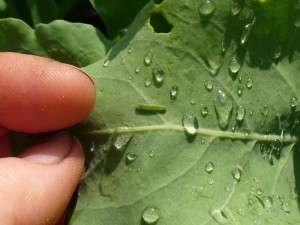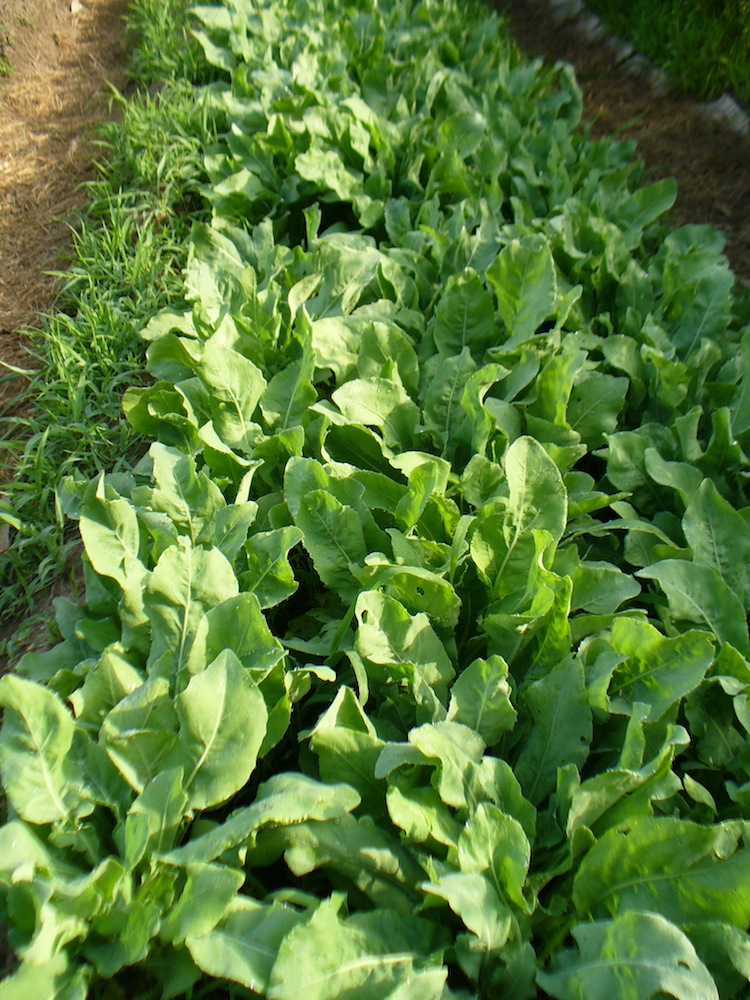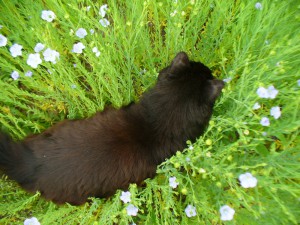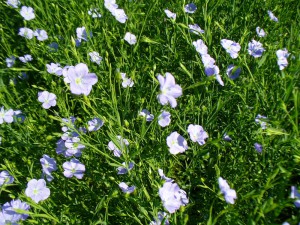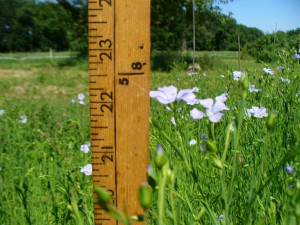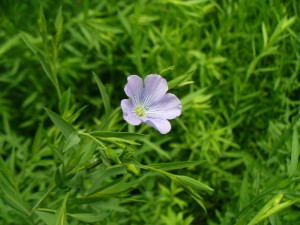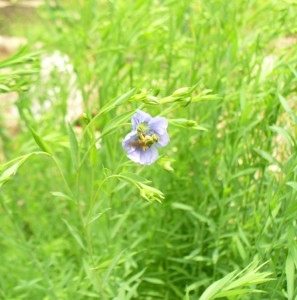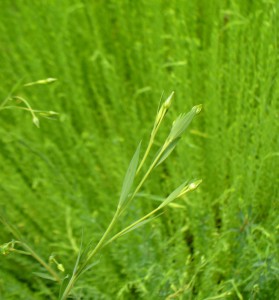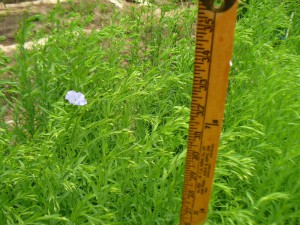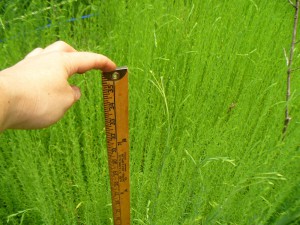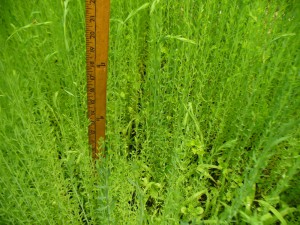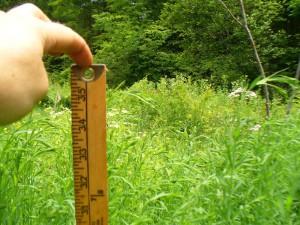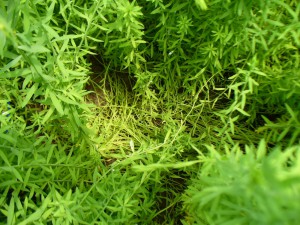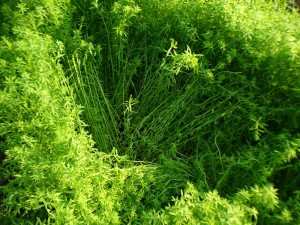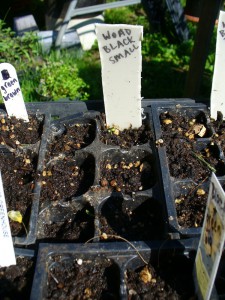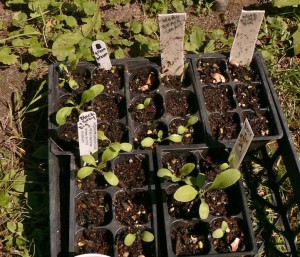Between Wednesday July 11th and Monday July 16th I pulled up all my flax. I started a bit earlier than 90 days after planting (I planted all the plots the same day, April 15th), and earlier than 30 days after peak bloom (which was around June 21st). These had been the two harvest benchmarks I had in mind all summer. However, we have had such hot, dry weather that despite my diligent watering efforts the flax was just done. Usually people recommend pulling it up when the lower third of the stalks turns yellow. I have typically pulled it when more like half or even two thirds of the stalk is yellow. You can see in the photos that this year a lot of the flax was entirely yellow, and a few stalks had even begun to turn brown. Continue reading “Flax Harvest at Small Ones Farm”
Woad Has Enemies
Every year I have problems with cabbage white caterpillars eating holes in my woad. Some years are worse than others. The caterpillars are hard to spot and pick off because they are the exact same color as the leaves, or more precisely, the veins. The butterflies are very pretty, of course, because they are butterflies. I have not been able to get a good photo of a cabbage white butterfly (same problem as my earlier bee post), but click on the link above to see some great ones (12/22/2023 Edited to add, the original link stopped working. The new link to UMass Extension is informative but doesn’t have a lot of images.). And the butterflies don’t do any harm, per se. It’s the caterpillars, or cabbage worms, that are the problem.
Here’s a photo of a particularly small and innocuous-looking one sitting on my woad:
Woad is Glorious
My woad beds are looking fantastic! I am very pleased about this. For the past couple summers, the woad plants at Amethyst Brook have been small and feeble compared to the woad I grew up at the dye- and fiber-plant garden at Bramble Hill Farm. This year the garden at Bramble Hill has been sadly neglected (well, I’ve been distracted by multiple flax plots), so the community garden is my sole source of woad. Consequently, I made an extra effort to add plenty of composted manure before planting this year. And ta-da, success. Here is one bed before I weeded it the other day:
Flattened Flax
I have been hesitating to post this because I don’t have much in the way of photo documentation, plus it’s sad. On Monday (June 25th) we had very heavy rain and thunderstorms. It had been very hot for a few days and I’d been watering the flax and garden each day, so I was glad for the rain. But on Tuesday I arrived at the community garden to a very sad sight. The v.n.s. looked as if someone had parted it with a comb down the middle of the bed, and then combed it flat on either side of the part. Flat. Poor flat flax. I hadn’t brought my camera, so there is no photo of the scene, but maybe you can conjure a mental image. I tried to fluff it up and shake off the excess water and encourage the stalks to stand upright again. They stood up a little, in a wobbly way, but I fear their former graceful and erect stature is gone forever. The Marilyn, which has already suffered from lodging, was also hard-hit. In contrast, the Evelin was not affected, happily.
Later on Tuesday I checked on the plot at Amethyst Farm, and there was a similar scene there.
Cat Nap Beds or Crop Circles
Last week when I went to check on the flax at Small Ones Farm, their barn cat, Squeak, was lolling about in the flax bed as if it was the perfect place to nap, or perhaps hunt mice. Or just to hang out. Flax does have a strong smell, even while it’s growing (and stronger still while it’s drying). Maybe it’s appealing in a catnip-like way. Who knows. Anyway, here’s Squeak in the flax.
I have several other photos, but this is pretty cute. Continue reading “Cat Nap Beds or Crop Circles”
Flax Blossom Image Gallery
Happy Solstice to all! Here in Amherst it is a sweltering, bright, gloriously sunny day. Flax is in full bloom. Even though hot weather is not necessarily to flax’s liking, it has been looking stately and graceful over the past several days. I’ve been giving it extra water for encouragement.
I find flax in bloom to be unspeakably beautiful–the sweet little five-petaled structure and luminous blue color of the flowers themselves, and the way the flowers and the bright green foliage of the plants vibrate and glow together. I have taken ridiculous numbers of photographs trying to capture the exhilarating feeling of the plants and blossoms. Here are some close-ups:
Photographing Bees
I have been impressed with how many bees I see at every plot, even though only Amethyst Farm actually has honey bee hives on the property. I enjoy their little buzzing sounds, which are as soothing and blissful as a cat’s purr. I love watching them bumble up and down, and the way a flower head droops down when the bee lands. Happy bees feasting in flowers is quintessential summertime.
However, attempting to photograph bees visiting the flax flowers is like photographing fairies. I have always had a fondness for mysterious creatures such as Big Foot and the Loch Ness Monster, and have always felt sympathetic about the difficulties of photographing such elusive beings. However, getting photographic proof that the bees are actually there in the flax is proving to be as challenging as getting a clear shot of Nessie. I take photos of where the bee *was* but of course in the time that it takes to actually take the photo, the bee has moved on. And then there’s the fact that the camera will focus on other things besides the bee…. Here are some attempts:
Hmm, no bee at all. Continue reading “Photographing Bees”
More Flax Blossoms
Well, two months after planting, all the flax is blooming. This is exactly as it should be, and is very reassuring in a year when plants are otherwise not synched up with my sense of when they should be blooming (Queen Anne’s Lace already in bloom? What? Chicory??? No!!!). But, more on this later….
Back to flax news! At Amethyst Brook and Small Ones Farm, the v.n.s. wins the prize for most prolific flowers compared to Evelin and Marylin, at least at this point, at least at the times of day that I’ve observed the plants. At Amethyst Farm, I do not not observe a big difference in the number of flowers blooming between the v.n.s and Evelin, but there is a difference in height, as you will see in a moment.
Here are the plants at Small Ones Farm, as of yesterday morning, June 15th (exactly two months since planting). First, the tallest v.n.s. plants, at just over 22 inches high:
Flax is Starting to Flower
The flax in starting to bloom! These photos were all taken yesterday, June 12th, at our community garden plot at Amethyst Brook. The first variety to flower was the non-specified variety from Richters. It’s a tad shorter than the other two varieties overall, and as you may recall, it came in a little thin. This has meant that the individual stalks have more room to spread out, and the leaves seem larger on the v.n.s. than on the other two varieties. Spreading isn’t considered desirable with fiber flax, because the more branches the plant develops, the shorter the fibers will be.
Here’s one of the first beautiful flowers on the v.n.s.:
In this photo I happened to catch a little green bee-like pollinator at work. Sorry it’s blurry, but I didn’t even realize it was there until after I took the photo.
Last year I learned from Cliff Hatch at Upinngil Farm that flax flowers are pollinated by bees and other insects, and will not produce a lot of viable seed without them. I am not trying to save seed this year (hence I am growing more than one variety close together). There aren’t any beehives near the Amethyst Brook gardens, but as you can see, we get a few other pollinators.
The Evelin was full of buds yesterday, but no flowers yet:
There was one flower just barely unfurling in the Marylin bed (or Marilyn, who knows–I’ve seen it written both ways):
Measuring the heights of the plants proved a bit trickier to do by myself than I thought it would be. Again, apologies for the quality of the photos. Next time I will bring along an assistant.
The v.n.s. is about 33 inches high:
The Evelin is about 35 inches high, though there is a patch where all the plants are much shorter (one to two feet) and more spindly:
The Marylin is a full 36 inches and some plants are taller.
However, it has suffered from lodging, which is when the plants fall over and don’t straighten up again.
noticed the lodging at the end of May. Here’s how it looked on May 28th.
I decided not to do anything to correct the problem (for example, staking). The point of the whole exercise this year is to see how different varieties compare under similar conditions. The Marylin came in very thickly compared to the other two varieties, and grew much faster initially. I think this may be have due, in part, to the competition between the plants. In theory, you want to sow thickly so the plants will grow as tall as possible and as straight as possible, without branching. However, perhaps they outpaced themselves, and got too tall for their own stalks to support. Maybe Marylin needs to be planted less densely.
Anyway, that’s the news from flax land.
Woad Seed Germination Experiments
In my last post I referred to the germination experiments I did last summer and I went back through old posts so that I could link to the one about woad seeds. However, it turns out that I never wrote about the woad seeds. I spent a long time writing about weld seeds, in the category of “what I did this summer,” then moved on to writing about fall projects.
Here is the belated summary of my woad seed experiments from summer 2011.
I sorted the seeds by color and size. Categories included “black big,” “black small,” “green brown,” “black and gray big,” and “black and green big.” I planted them into little cells with labels.
Here’s a photo of the set up.
And, in short, they all grew. Oddly, the “black big” took longer to grow.
My conclusion from this experiment was that I didn’t need to sort woad seeds and save only the biggest or darkest in color. Also, you need to plant at least twice as many seeds as the number of plants you want, since in each color-and-size category the germination rate was low. I don’t know whether the appearance of the seed has any relationship to the amount of color a plant produces. I doubt it, but it would be hard to prove.

